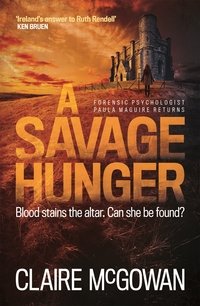A Savage Hunger by Claire McGowan
Claire McGowan’s Paula Maguire series brilliantly portrays the long term consequences of the Irish Troubles through generations. This book also explores social attitudes toward food and hunger.
After the temporary Missing Persons Research Unit of Ballyterrin is disbanded, cross-border cooperation between Irish police forces of North and South is “back to being intermittent and suspicious.” Among the population of the North, the willingness to help police is often grudging, sometimes entirely absent. Even those who run the retreat on Lough Derg use religion as a shield against allowing cops to question their guests in case they may have information about a missing person. An anorexic young woman has vanished in suspicious circumstances. Astonishingly, the “privacy” of retreat guests is given priority over allowing the police to ask questions that might help find her.
Forensic psychologist Paula Maguire is obsessed with finding the missing, in particular, young girls. She still doesn’t know the fate of her own mother, who disappeared when Paula was in her teens.
Hope of learning more about her Mum’s fate flares briefly when Sean Conlon, an IRA man imprisoned for crimes committed after the peace accord, suggests he might have information. He implies that he’ll tell Paula what he knows in exchange for early parole. Shortly after, Sean is released from prison and Paula’s hope for news of her mother fizzles once again. Disheartened, she fears her mum’s case will be “swept under the carpet of reconciliation and peace and it’s-not-really-worth-the-bother, if it mean[s] people dying in the street again.”
Then Sean is murdered, and Paula’s fiance is suspected. Did Aidan really kill him, or was Sean’s demise a settling of old scores? The town feels “febrile,” and it seems more trouble is on the way. Gloomy and pessimistic, Paula watches while life goes on in the way that passes for normal in the North. People will “riot and burn things,” everyone will “enjoy themselves, except the police,” who will “get spat at and dodge stones and wonder if anyone in the crowd happens to have a gun.”
As the title suggests, this novel also explores ideas of hunger. It opens with a devastating scene from the orchestrated hunger strikes of 1981. There are also references to the potato famine. Unlike Paula, most of the women of contemporary Ballyterrin consider it normal to attempt to reduce. Anyone planning to get married is assumed to be dieting in order fit into her wedding dress. The missing Alice is “a girl with anorexia at a [saint’s] shrine for the hungry.”
Doing online research into the case, Paula comes across a picture of a woman dying of starvation in Sudan, and discovers websites devoted to the pursuit of thinness. One gives girls tips on how to lose weight, “how to hide your eating habits from friends and family. How to cheat at weigh-ins” and “never eat in public. How to die, slowly and willingly.” The anorexic girl on this site is almost as thin as the dying Sudanese woman, but the girl is smiling. When reading online about the Famine, the hunger strikes, and anorexia becomes too much, Paula clicks out of her research, feeling “the weight of the internet press upon her.”
Guy, a London colleague who works to get girls out of gangs, hates Facebook. He knows how social media perpetuates the unhealthy attitudes of women toward their own bodies. It’s an uphill battle to get the young to realize how it can be used against them, when they “put their whole life up there,” unwittingly exposing themselves to the potential of “a lifetime of exploitation masquerading as love.”
Hunger and violence are tied up together. In 1981 we see through the eyes of an IRA man, who reflects on life in the “crappy wee town on the border” that is Ballyterrin. “You’d been brought up to hate the RUC. If someone robbed your car or your house you’d ask the Provos to sort it out. Not the peelers, never the peelers in a million years, it would be betraying your kin and country.” Thinking about the hunger strikers, aware of how he’s been programmed, the “twenty-year-old man driving alone with a gun under the seat” still doesn’t want to be the one to strike the match to this “petrol-soaked shitstorm bonfire of a country.”
The Brits in the army consider him Irish scum, but on this day in 1981 they wave him through, “not a bother on him.” Sod’s law, he decides, as he carries on with his deadly assignment. Six hunger strikers are dead, and he feels the violence in the air, knows “there will be hell to pay.” In the midst of all this chaos, a different girl disappears. Knowing the RUC are “too busy to bother with some girl going missing,” the killer seems confident of not being caught.
Two decades on, history repeats itself as Alice vanishes. Paula and the other townspeople live with the legacy of the Troubles, which infiltrates every aspect of life and work in Ballyterrin. Northern Ireland holds Paula against her will in the hometown she feels unable to leave — at least until she finds the missing Alice and unravels the mysterious disappearance of her mother.

